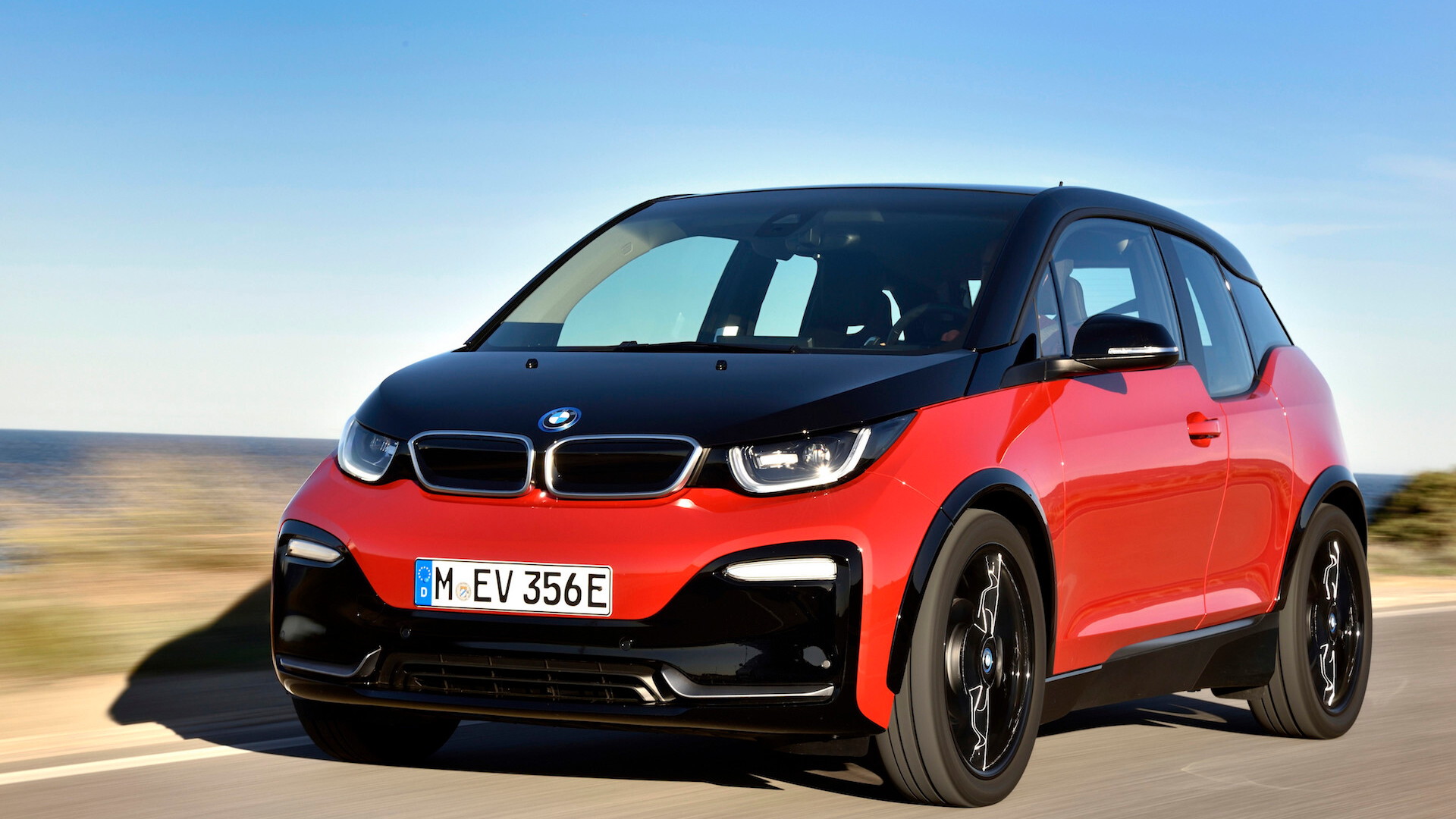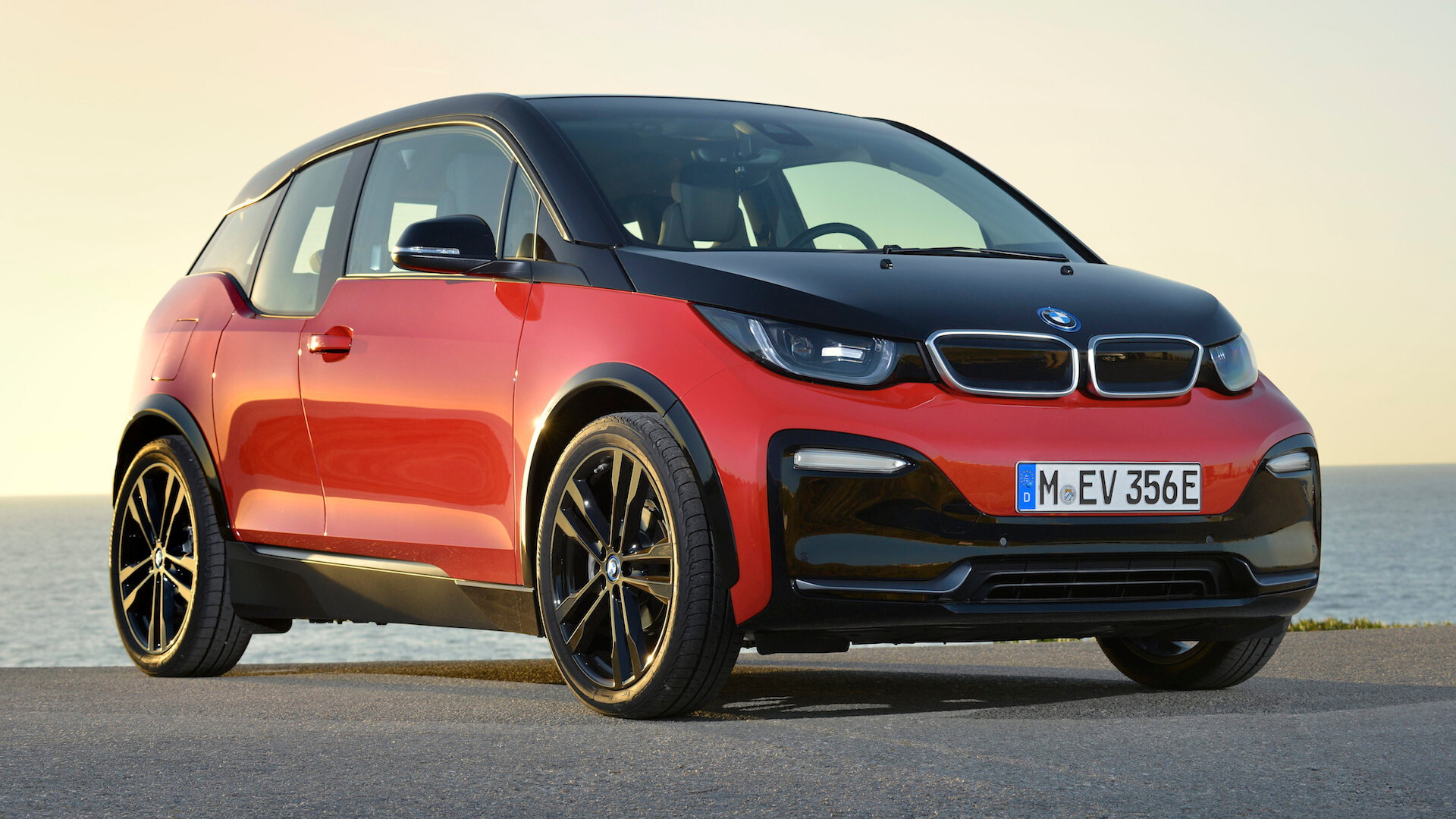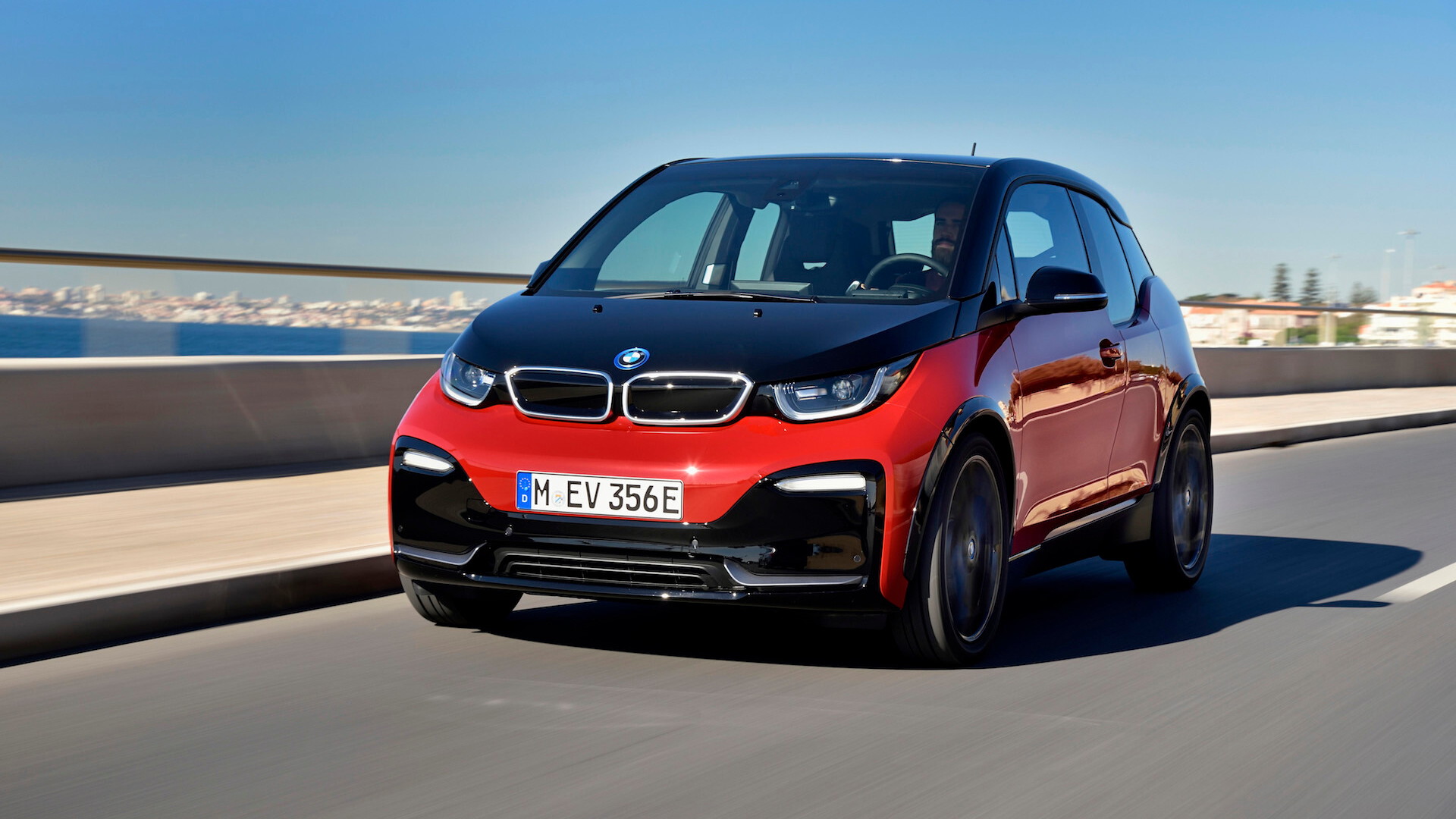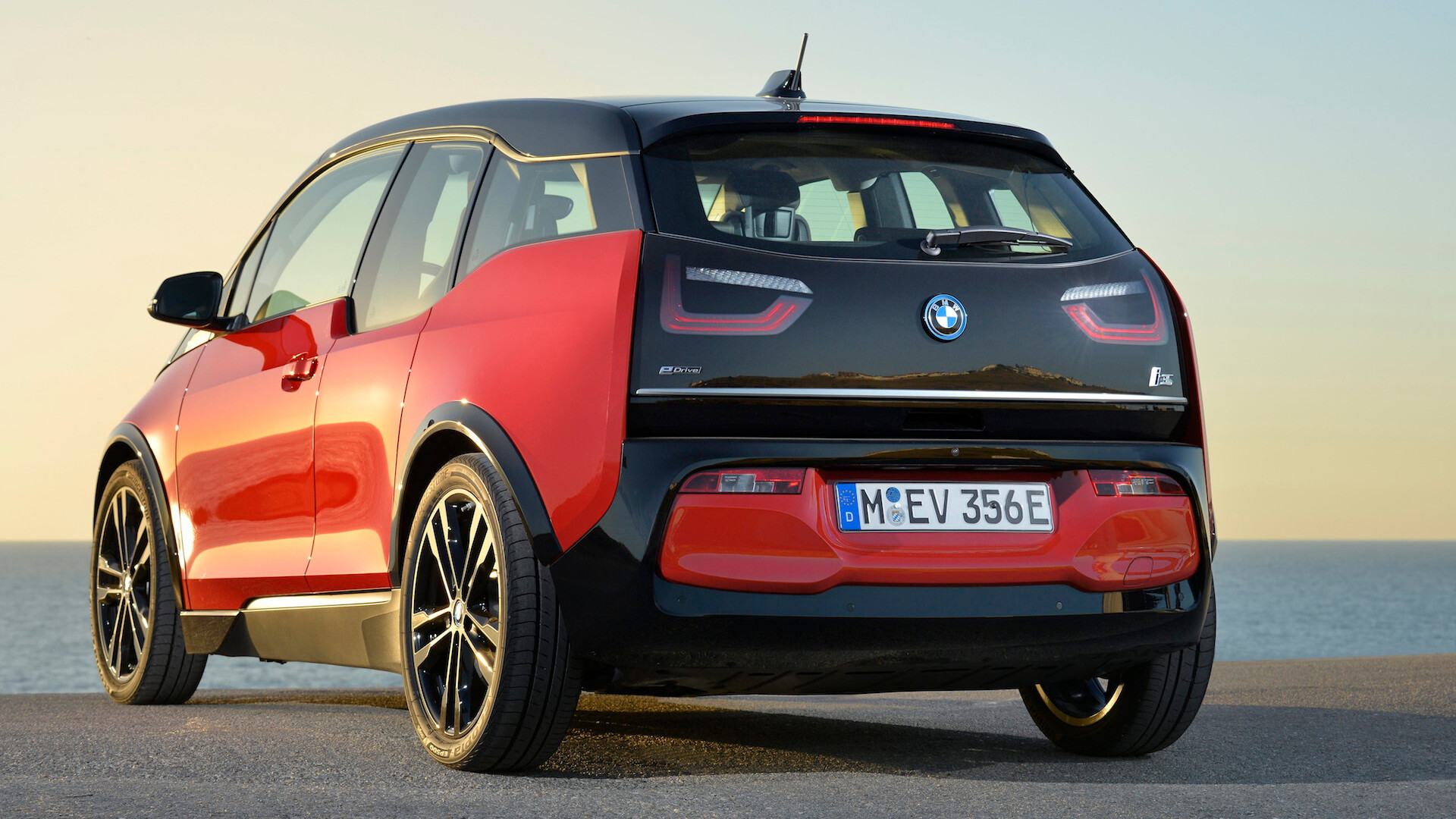BMW has added the i3s as a sportier model to the i3 lineup for 2018. It gets sportier suspension settings, wider tires, more aggressive bodywork, and a more powerful motor that puts out 137 kilowatts (184 horsepower) and 199 pound-feet of torque versus 127 kw (170 hp) and 184 lb-ft in the standard i3.
DON'T MISS: BMW will have 25 electric cars, plug-in hybrid models by 2025
Commuting
I’m starting off the day with an 18-mile drive to the track in the i3s. The 33-kwh battery has almost a full charge and it shows 88 miles of range when I put the drive-mode selector in Eco Pro Plus mode. I want to get a feel for the various modes on my route, so I try them all, but I have an eye toward efficiency, so I’m running in Eco Pro and Eco Pro Plus most of the way.
Those two modes come close to one-pedal driving, as the brake-energy regeneration kicks in pretty hard when I let off the accelerator pedal. Acceleration is dulled a bit, too, but this car is still quick off the line.

2018 BMW i3s

2018 BMW i3s

2018 BMW i3s

2018 BMW i3s
In Eco Pro Plus, the accelerator pedal has a detent that “limits” the speed to 56 mph. Tip it in farther, though, or floor it off the line, and the car gets the hint: it will go faster than 56 mph, all the way up to 100 mph, 7 mph faster than the standard i3.
Eco Pro is programmable. You can set that detent between 50 and 80 mph, and choose a more efficient mode for the climate control system. A display on the center screen will show you how efficient you have driven based on the settings you choose, and the range is between 70 and 100 percent.
When I come to a couple of stop signs on the edge of town, it’s time to try some full acceleration sprints. I come to a stop, let the brake regen do most of the work, toggle the steering column-mounted selector to Sport, then jump on it. The car gets up and goes with impressive but silent verve, hitting 60 mph in 7.6 seconds, 0.4 second faster than the base i3.
It should be noted, however, that I’m in an i3s with the range-extending 2-cylinder engine, which adds 273 pounds and brings the total to 3,278 pounds. Without that little 0.6-liter, the i3s hits 60 mph in 6.8 seconds compared to 7.2 seconds for the all-electric base i3.
The steering also takes on a heavy feel in Sport mode. In fact, despite its light weight due to its carbon fiber-intensive construction, the whole car feels heavy. Must be due to that battery sitting low in the body.
After a couple acceleration runs, I try out Comfort mode, which is a good compromise between the weight and response of Sport and the dull feel of the Eco modes.
Then it's back to Eco Pro Plus for the run to the track. I arrive with 86 miles of range remaining. Somehow, I only used two miles of range over 18 miles, despite some hard launches.
That’s impressive, and the i3s offers excellent efficiency ratings overall. With the range extender, it is EPA rated at 109 MPGe and 35 mpg combined. Those numbers match the standard i3, but without the range extender the numbers are down slightly to 126 MPGe city, 99 highway, 112 combined versus 129/99/118 mpg for the i3.
Now for something completely different
After laps on the track in the M5, it’s time for a curveball: BMW has set up an autocross for the battery electric version of the i3s. This is where some of the changes from the i3 come into effect.
Compared to the i3, the i3s has a sport suspension with a 0.4-inch lower ride height, a 1.6-inch wider track, and firmer springs, dampers, and anti-roll bars. The motor makes more power thanks to modified motor control programming and unique taper roller bearings, which help most at higher rpm.
MUST SEE: 2018 BMW i3s: range, efficiency lower for sportier model of electric car
The tires are also wider and larger. The i3s has 175/55R20s up front and 195/50R20s in the rear, while the i3 comes with 155/70R19s at all four corners. A little more rubber should provide more traction, but it’s going to be hard to keep the front end from sliding out.
I set the drive mode to Sport, turn the stability control off, and set off on three runs.

2018 BMW i3s, BMW Test Fest autocross, February 2018

2018 BMW i3s, BMW Test Fest autocross, February 2018

2018 BMW i3s, BMW Test Fest autocross, February 2018
The i3s is a mixed bag in an autocross. The immediate torque from the electric motor is ideal here, providing great pickup off the line and quick response out of turns.
However, I was right. I’m pretty competitive in these situations, so I attack the corners with as much speed as I can and find that reining in the front end is very tough. The skinny tires give up grip too easily, causing me to waste precious time understeering (sliding forward instead of carving corners).
I’m able to cut 1.5 seconds off my time by my third run, but I’m still fighting understeer despite cutting my speed in the corners. It’s fun, but frustrating.
The way back
At the end of the day, I hop in another i3s with the range extender. This one shows 14 miles of range with 18 miles to the hotel.
Once again, I switch between modes, but mostly drive efficiently in hopes that I can extend that 14 miles for the full 18. I come close, but run out of juice about a mile from the hotel. The engine starts, but I can barely hear it running and I make it to the hotel.
The car I’ve been driving has a starting price of $51,500, which represents a $3,200 premium over the base i3. It's equipped with the $1,800 Giga World leather and cloth upholstery, the $2,500 Tech + Driving Assist package (adaptive cruise control and navigation with real-time traffic), $300 blue seat belts, $750 parking sensors, $300 Apple CarPlay (SOBs!), and a $995 destination charge for a total price of $58,695.
At that price, the BMW i3s isn’t the most efficient EV, but it is more stylish and sportier than the base i3, and based on my drive, it doesn’t suffer much in terms of efficiency.
BMW provided travel and lodging to Internet Brands Automotive to bring you this firsthand report.




















